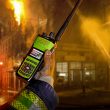Interoperability on the fly
Twelve hours before presidential candidate Barack Obama was scheduled to speak at Wright State University in Dayton, Ohio, public-safety officials asked the nearby Beavercreek Township Fire Department to provide communications support for the event. Six public agencies across two jurisdictions would be supplying personnel and resources, and our job was to link mobile communications between them.
Given the disparate radio systems of the agencies involved, the short notice could have presented a major interoperability headache. But thanks to careful development over five years, a team approach and the right technology, the event proved to be an exceptional demonstration of our communications response plan’s capability to support incident command.
Key to our response plan’s success was funding through an Assistance to Firefighters Grant from the Federal Emergency Management Agency in 2003. Resources provided by the grant enabled us to spend the last five years developing and refining our plan with a focus on communications interoperability. The resulting plan combines a three-person team concept with customized mobile radio gateways using radio control over IP (RCoIP), an advanced technology that permits remote control and monitoring of radios over an IP network connection.
The three-person team provides expertise in the critical areas of communications leadership, operations management and mobile radio technology. Team members include one officer with incident command experience as a communications leader, one operational technician who understands the general operations and how communications play into them, and one volunteer amateur radio technician. Over the last five years, the fire department has developed a bank of career-level personnel prepared to fill the first two roles through a selective process of interviews, aptitude testing and training.
The communications unit leader must have the ability to anticipate the needs of incident command and be prepared to present plans and options quickly. An officer with command experience can fill this role nicely. Although the person in this position doesn’t need to understand the technical workings of the interoperability equipment, he should have a clear grasp of the resources and capabilities available through the team. We have found it beneficial for this person to be present at briefings and have a solid line of communication with the command staff.
Operational experience is a must for the role of operations technician, which should be filled by a senior-level person who can understand new technology. This person will help develop communications plans for the command staff and be an integral part of bridging the gap between command’s needs and the available technology. This person must have a solid understanding of operational scenarios and how communications capabilities can affect them. This person also should be able to think logically and technically in order to troubleshoot problems. The choice of technology is critical to this role. Our RCoIP solution is simple to implement and adjust, reducing both the training time required and the operations technician’s ability to respond quickly and effectively to the dynamic needs of public safety.
The volunteer amateur radio technician provides the technical understanding that usually takes years to develop and is rarely found in public service. The FCC exam required for an amateur radio license gives us a measure of basic skill. We find this role best-served by people affiliated with local Amateur Radio Emergency Services (ARES) organizations. These folks have an expert understanding of the radio technology being used and how the interconnections will affect each of the radio systems involved. And because they are volunteers, this group’s participation also opens the door for good community relations. Their enthusiasm for this user-friendly experience is contagious, translating into new interest in our communications program from the general public
Our team concept deploys the communications unit leader as a forward resource. This person begins by interfacing with command to determine the need for additional resources, as well as where they will be used best, on scene or remotely. In the case of Obama’s campaign visit, we received the last-minute request for communications support from the university campus police, with whom we already had a successful working relationship. This came about several years ago when university safety officials attended a fire department open house held to showcase the IP-based mobile radio gateways our grant funds had purchased from Catalyst Communications.
After learning about the new equipment’s interoperability features, the university began requesting communications assistance for major events such as large concerts. This proved to be mutually beneficial in that it gave us regular opportunities to practice our new interoperability capabilities. Most events required us to connect four law enforcement agencies and a private security company, as well as manage communications for fire and EMS, university services, and concert staff.
Our unit leader attended the Obama pre-event briefing and assessed the needs, which involved linking communications between the different proprietary systems of campus police, the county sheriff’s office, state patrol, local police department, a neighboring police department and a neighboring county’s bomb squad. Fortunately, an incident action plan had been prepared that had only a few minor information holes. Based on this plan, the unit leader identified and requested the necessary resources, which included one mobile unit from the Buckeye State Sheriff’s Association — one of 12 mobile units staged throughout the state — and three fixed Catalyst IP-based radio gateways from the Beavercreek Fire Department.
The communications unit leader was responsible for the management and accountability of the resources assigned to him. At the height of the event, these resources included three fire department technicians, two sheriff’s office technicians, two mobile communications units, and the three gateways that were located at nearby Beavercreek fire stations. With our team approach and cutting-edge equipment, we created a sophisticated patch between systems that ordinarily would be incompatible and maintained full control of remotely located radios.
During the event, we encountered a few snags, mostly due to a lack of common channels, or talk groups, in individual radio programming and incompatibilities between key radio features such as digital and analog modes. On the fly, the communications team developed a revised plan designed to address these challenges and presented it to the command staff. The staff’s preferred option required an additional mobile unit with specific radio capabilities, which included a Project 25 conventional simplex channel. The additional mobile unit was required due to the short range of the simplex channel; to patch units using this channel, we needed a unit within range of the working portables.
This allowed for two extra channels that all components could share. The revised plan allocated one of these channels for fire incidents and the other for EMS incidents, with contingent patching through the communications unit if necessary. In less than an hour, the communications unit leader requested and received the resource from the sheriff’s office, gave deployment instructions, and integrated the unit and its staff into the incident command structure. From there, the communications plan continued to run without major incident.
Using the desktop dispatch component from Catalyst, the on-site dispatcher remotely managed the working units from a safe distance in a protected environment. Features such as unit ID history, call recording/playback, channel change and scan, and radio summing/scanning allowed the dispatcher to monitor multiple radio channels for the command staff. The dispatch technology made it easier for extra personnel and resources to be released, debriefed, and returned to service as soon as practical to be deployable for other needs.
The Obama campaign event put our team concept and communications response plan to the test, providing an excellent demonstration of how an investment in careful planning and interoperability technology pays off. The event highlighted the importance of an incident action plan and communications technology that can be reconfigured quickly and remotely as public-safety needs evolve. Both are critical reqirements for compliance with the management practices specified by the Department of Homeland Security’s National Incident Management System. Effective management of communications results in safer and more productive operations, maximizing public safety and minimizing headaches and stress for personnel.
Lt. Nathan Hiester is the communications officer at the Beavercreek Township (Ohio) Fire Department.
12 hours
Notice given to provide communications support for a presidential campaign rally.
PLANNING PAYS OFF
Systems interconnected during Barack Obama’s presidential campaign stop:
- 800 MHz Motorola Smartnet system for the university
- 800 MHz M/A-COM EDACS system for the county sheriff’s office
- 800 MHz Motorola Omnilink System for the state patrol
- VHF P25 digital simplex channel for the local police department
- VHF analog simplex channel for neighboring police department
- 800 MHz Motorola Smartnet system for neighboring county bomb squad
- Local on-site desktop dispatch using Catalyst IP Remote platform
Source: Beavercreek Fire Department

















